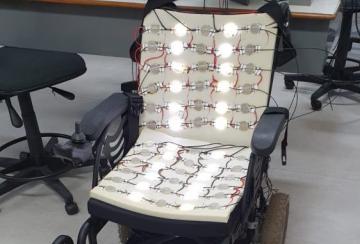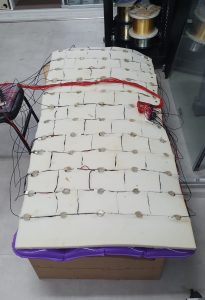
Assistive technology chair and mattress help prevent illness
- Post by: roseli
- 22/09/2022
- Comments off
A project developed jointly by the Telecommunications (LabTel), Robotics and Assistive Technology (LRTA) and Computing and Neural Systems (Swan) laboratories of the Department of Electrical Engineering at Ufes, proposes the use of fiber optic sensors in wheels and pneumatic mattress in order to monitor users’ posture, helping to prevent diseases. The adapted chair allows commands made by the movement of the neck.

The chair project is being developed by the Master’s student Ximena González, from the Graduate Program in Electrical Engineering (PPGEE/Ufes), under the joint coordination of professors Teodiano Bastos and Camilo Diaz. In the research for the development of the mattress, there is the participation of the PPGEE master’s student Anny dos Santos, under the coordination of Professor Evandro Salles.
Find out about other research carried out by Ufes on the Revista Universidade website.
González explains that the chair with sensors, which are produced with polymeric fiber and have a low cost, can help prevent diseases caused by poor posture of the user. “In the chair, we work with monitoring and control. We have an array of force and pressure sensors, which, when pressed, will generate data in a computer application, making it possible, from this information, to analyze the person’s posture. Thus, we can infer whether this person has an adequate posture or if he has been in a wrong posture for a long time. This can generate an alert and help prevent disease,” he explains.
Chair control is provided by a neck pillow. “A sensor control line will be replicated and installed on the pad. The idea is to control the wheelchair with neck movements. The pressure on the sensors, which will also be installed on the cushion, can move the chair forward, backward, sideways and also diagonally”, says the student.
The devices have already had their tests started, the chair is ready and the next step will be the collection of information after use by users. The next phase will be data processing to understand what happened to the user’s posture through the variations presented by the sensors.

Professor Camilo Diaz says that, although the chair and the mattress are based on the same principle – instrumentation with fiber optic sensors – the devices will have different functionalities. “On the mattress, our goal is to monitor and analyze pressure ulcers in bedridden patients. With this, in the case of a pneumatic mattress (with air bags that can be inflated or deflated using a pneumatic pump), it will be possible to monitor the places that have the highest pressure on the user and, from there, control the flow of air to make the pressed part softer”, he explains.
Cost and applicability
Diaz points out that the process of producing sensors in polymeric fiber optic is low cost, being carried out in LabTel. “In terms of sensors, polymer optic fiber is a cheap option and does not require a very sophisticated structure to be made. The process is artisanal and has been carried out in our laboratory, but nothing prevents us from replicating it on industrial scales,” he explains.
He also points out that sensors made with this material can be installed in other devices. “This same project can be transferred to a sofa, for example, to monitor the heart rate, posture and breathing of the user who is seated. We can also think about the applicability in car seats for those drivers who spend a lot of time driving, such as truck drivers”.
The project and the laboratories are funded by the Espírito Santo Research Support Fund (Fapes), the National Council for Scientific and Technological Development (CNPq) and the Coordination for the Improvement of Higher Education Personnel (Capes).
Text and photos: Vitor Guerra (Communication project fellow)
Editing: Sueli de Freitas
